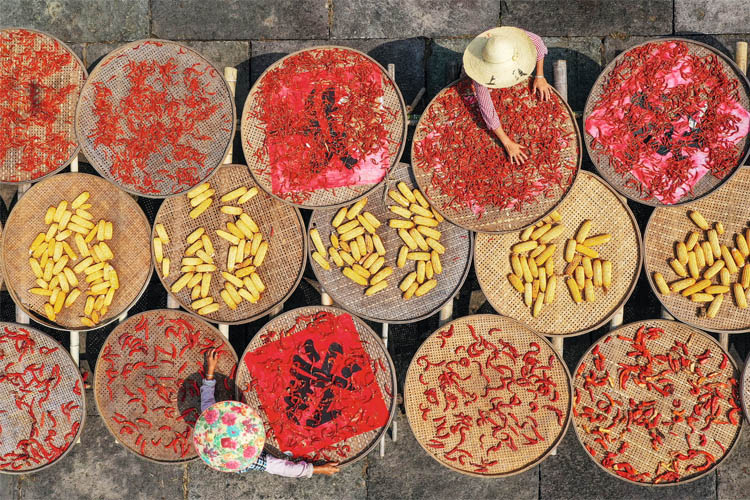Memorable Events of 2022

2022 was an unusual year for China.
The 20th National Congress of the Communist Party of China (CPC) was held in October. The report delivered by Xi Jinping, general secretary of the CPC Central Committee, to the congress, unveiled a blueprint for advancing the rejuvenation of the Chinese nation on all fronts through a Chinese path to modernization.
By the end of the third year in the pandemic, China decided to shift the focus of its COVID-19 response strategy from infection control to treatment of severe cases. The country downgraded its level of COVID-19 management from Class A to a less strict Class B in January 2023.
The year 2022 witnessed China’s endeavors to open up further. The 24th Olympic Winter Games were held in Beijing in February, making it the only city to host both Summer and Winter Games. The China International Import Expo has been held for five consecutive years in Shanghai.
China hasn’t slowed its pace of technological innovation. Chinese astronauts met in the country’s space station for the first time. The first C919 large passenger aircraft was delivered to China Eastern Airlines. It was the Chinese civil aviation transport market’s first usage of an indigenously-developed mainline jetliner.
The year 2022 also witnessed seven Chinese cities be listed as international wetland cities, making China the country with the most internationally certified wetland cities in the world, a symbolic achievement validating China’s decades of efforts in environmental protection.
With vigorous and determined endeavors, China continues to forge ahead.

The 20th National Congress of the Communist Party of China (CPC) opens at the Great Hall of the People in Beijing, capital of China, October 16, 2022. (Photo by Wan Quan/China Pictorial)
Chinese Modernization
The 20th CPC National Congress was held from October 16 to 22 in Beijing. Chinese modernization as a key term defining China’s journey to rejuvenation was finally written into the report to the 20th CPC National Congress. In his report to the congress, Xi Jinping, general secretary of the CPC Central Committee, underscored the “central task” of the Party, calling for efforts to advance the rejuvenation of the Chinese nation on all fronts “through a Chinese path to modernization.”
The report to the 20th CPC National Congress describes the Chinese path to modernization as the modernization of a huge population, of common prosperity for all, of material and cultural-ethical advancement, of harmony between humanity and nature and of peaceful development.
“The Chinese path to modernization and Western modernization are not necessarily mutually exclusive. They can be complementary to each other, with both driving the modernization of human civilization writ large.”
—Chen Haiming, professor and director of the Center for Global Governance and Law at Xiamen University of Technology

Chinese skier Gu Ailing competes in the women’s freeski big air final at the Big Air Shougang in Beijing, February 8, 2022. (Photo by Chen Jian/China Pictorial)
Dual-Olympic City
The Beijing 2022 Olympic Winter Games were held from February 4 to 20 last year. Beijing became the first city to host both Summer and Winter Olympic Games. Nearly 3,000 athletes from 91 countries and regions joined this Winter Games. Among the 12 competition venues, five were legacy venues of the Beijing 2008 Summer Olympics. All Beijing 2022 venues have legacy plans in place, ensuring their post-Games multipurpose use all year round.
“It is obvious that the athletes are happy and are more than happy. They are extremely satisfied with the venues, with the Villages, with the services having been offered, and with the safety within the closed loop under these very difficult circumstances.”
—Thomas Bach, president of the International Olympic Committee

A C919 large passenger aircraft numbered B-919A is ready to fly from Shanghai Pudong International Airport to Shanghai Hongqiao International Airport, marking the delivery of the world’s first C919 large passenger aircraft to China Eastern Airlines, its first buyer, December 9, 2022. (Photo by Wan Quan/China Pictorial)
C919
The first C919 large passenger aircraft was delivered to its first customer, China Eastern Airlines, on December 9, 2022. It was the first time ever for China’s civil aviation transport market to purchase an indigenously-developed mainline jetliner.
With registration number B-919A, the aircraft completed its maiden flight from Shanghai Pudong International Airport to Shanghai Hongqiao International Airport during the delivery process. The 164-seater aircraft comes with a two-class cabin layout, consisting of business class and economy class. “The comfort and stability of the aircraft are excellent,” said Zhang Chi, deputy general manager of the cabin department of China Eastern Airlines, who took the very first flight. Compared with other planes he has flown in, the C919 is high-end, with little noise during the flight, according to Zhang.
“China’s C919 large passenger aircraft has been offered to the civil aviation market as a new plane with good quality and low price. And the development of the C919 aircraft marks the takeoff of China’s aviation industry and large aircraft manufacturing.”
—Shen Haijun, professor at the School of Aerospace Engineering and Applied Mechanics

Farmers in Chengkangu Village, Anhui Province, dry harvested crops in the sun, August 24, 2022. (Photo from CNS)
Rural Revitalization
2022 was a critical year for China’s drive to comprehensively promote rural revitalization and accelerate agricultural and rural modernization during the 14th Five-Year Plan period (2021-2025). Last February, China unveiled its “No. 1 central document” for 2022, outlining vital tasks to comprehensively push forward rural revitalization. The document vowed to “firmly maintain the bottom lines of guaranteeing China’s grain security and ensuring no large-scale return to poverty” and “promote rural development, rural construction, and rural governance in a solid and orderly manner.” The report to the 20th CPC National Congress held in October 2022 stated: “The most challenging and arduous tasks we face in building a modern socialist China in all respects remain in our rural areas. We will continue to put agricultural and rural development first, pursue integrated development of urban and rural areas, and facilitate the flows of production factors between them. We will move faster to build up China’s strength in agriculture and steadily promote the revitalization of businesses, talent, culture, ecosystems, and organizations in the countryside.”
“With in-depth implementation of the rural revitalization strategy, farmers’ sense of gain, happiness, and security have greatly improved. At the same time, it should also be noted that problems of unbalanced and inadequate development in China are still prominent. Promoting common prosperity for farmers and rural areas will be a long-term task. We must keep both feet on the ground, work hard, and strive towards this goal for a long time.”
—Wu Xiao, director-general of the Department of Rural Economy under the National Development and Reform Commission of China

A flag-raising ceremony is held by the Hong Kong Special Administrative Region Government at the Golden Bauhinia Square to celebrate the 25th anniversary of Hong Kong’s return to the motherland, July 1, 2022. (Photo from Xinhua)
25th Anniversary of Hong Kong’s Return to the Motherland
The 25th anniversary of Hong Kong’s return to the motherland was celebrated on July 1, 2022. John Lee Ka-chiu was sworn in as the sixth-term chief executive of the Hong Kong Special Administrative Region. The principle of “one country, two systems” has proved to be the best solution to the historical question of Hong Kong and the best institutional arrangement to ensure Hong Kong’s long-term prosperity and stability after its return. Chinese President Xi Jinping delivered an important speech at the celebration, featuring a blueprint for the development of Hong Kong and clarification of the direction of the steady and sustained implementation of the “one country, two systems” principle.
In 2021, Hong Kong’s economy grew to HK$2.86 trillion (about US$364 billion), up from HK$1.37 trillion in 1997. During the period, its total foreign trade in goods more than tripled to HK$10.27 trillion. The average life expectancy in Hong Kong in 2021 stood at 83 years for males and 87.7 years for females, compared to 76.8 years and 82.2 years in 1997, respectively.

A bird’s-eye view of golden rice fields and beach covered with seepweed in Panjin City, northeastern China’s Liaoning Province, October 5, 2022. On June 9 that year, the official website of the Ramsar Convention unveiled the second group of “international wetland cities.” Seven in China including Hefei, Jining, Liangping, Nanchang, Panjin, Wuhan, and Yancheng were listed. (Photo from IC)
International Wetland Cities
An accreditation ceremony was held during the 14th Meeting of the Conference of the Contracting Parties (COP14) to the Ramsar Convention on Wetlands on November 3. Seven Chinese cities received certificates of “international wetland cities,” making China the country with the most.
This year marks the 30th anniversary of China’s accession to the convention. Since then, China has established and improved its legal framework for wetland protection as well systems for protection management, project planning, and investigation and monitoring and has actively fulfilled its obligations under the convention while continuing to expand international cooperation in this regard.
“I want to say that in celebrating these 30 years, it’s really been an honor to realize and see the wetlands leadership from China reach beyond the national jurisdiction of China. I look forward to the next 30 years.”
—Musonda Mumba, secretary-general of the Ramsar Convention at an event titled “China’s 30 Anniversary of Accession to the Ramsar Convention: Achievement and Outlook”

A statue of Jinbao, the mascot of the China International Import Expo (CIIE). The fifth CIIE was held in Shanghai from November 5 to November 10, 2022. Leading enterprises from various industries joined 284 of the Fortune Global 500 companies in participating in the expo, and a total of 438 new products, technologies and services made representative debuts. Intended turnover reached US$73.52 billion on a year-by-year basis, hitting a record high. (Photo by Xu Xun/China Pictorial)
Openness and Prosperity
Entering its fifth edition in 2022, the China International Import Expo (CIIE) in Shanghai has become a vital platform for promoting trade, investment, and global cooperation and a “golden gate” to the vast Chinese market.
The fifth CIIE attracted participants from 145 countries, regions, and international organizations. Enterprises from 127 countries and regions were involved, including every member state of the Regional Comprehensive Economic Partnership, the world’s largest free trade deal so far.
A total of US$73.52 billion worth of tentative deals were reached for one-year purchases of goods and services at the fifth CIIE, up 3.9 percent year-on-year.
“The CIIE plays an important role in promoting economic globalization and open trade and thus underscores China’s strategic attitude towards a continuous opening-up policy.”
—Oliver Zipse, chairman of the Board of Management of BMW AG

A logo for digital renminbi (RMB) services of the Bank of China is displayed during the 2022 China International Fair for Trade in Services in a venue at Beijing’s Shougang Industrial Park. (Photo from IC)
Yuan Globalization
The Chinese currency, the renminbi (RMB), became the fourth most active currency for global payments according to the 2022 RMB Internationalization Report released by the People’s Bank of China, the country’s central bank.
Cross-border RMB receipts and payments in non-banking sectors hit a record high of 36.6 trillion yuan (US$5.1 trillion) in 2021, up 29 percent year-on-year, according to the central bank’s report. The net inflow of cross-border RMB settlements stood at 404.47 billion yuan (US$57.78 billion).
“In recent years, China’s advantages in global industrial chain and supply chain have become more prominent. The opening of China’s financial market has progressed steadily. The mechanism for setting the exchange rate for the renminbi has been continuously improved, and cross-border capital flows have been increasingly steady. This is helping China better cope with changes in the external environment.”
—Wang Chunying, deputy administrator and spokesperson of the State Administration of Foreign Exchange

After the three astronauts of the Shenzhou-15 manned spacecraft successfully reached the space station, the two teams of astronauts accomplished China’s first “space rendezvous.” (Photo courtesy of cmse.gov.cn)
Met in Space
Launched on November 24, 2022, China’s Shenzhou-15 manned spacecraft successfully docked with the space station combination early on November 30. The spacecraft conducted a fast automated rendezvous and docked with the front port of the space station’s Tianhe module at 5:42 a.m. It was the first time for the Chinese astronauts aboard the space station to welcome a visit from a crewed spaceship.
The Shenzhou-14 manned spacecraft separated from the space station combination at 11:01 a.m. on December 4 and returned to Earth safely. The Shenzhou-14 crew members, Chen Dong, Liu Yang, and Cai Xuzhe, lived and worked in the space station complex for 183 days.
“China has made such incredible advances, and I just enjoy watching their developments and hope to see us all working together more in the future. It would be my goal that definitely all the space-exploring countries of the world can work together on some projects in the future, maybe building a joint base on the moon or a base on planet Mars.”
—Don Thomas, a retired NASA astronaut

Nine large harvesters rumble forward in the golden paddy field in Jiangchuan Farm of Beidahuang Agricultural Reclamation Group in Jiamusi, northeastern China’s Heilongjiang Province, marking the beginning of the harvest of hundreds of hectares of rice, August 28, 2022. (Photo from IC)
Food Security
China has been improving its capability of ensuring food security over the past decade, with higher annual grain output and stable market operation. The country’s grain output has remained above 650 million tons for seven consecutive years.
Chinese President Xi Jinping noted in a written speech at the International Forum on Hybrid Rice Assistance and Global Food Security in Beijing on November 12, 2022 that food security is fundamental to human survival. Half a century ago, hybrid rice was first successfully developed and planted widely in China. Thanks to this technology, China has managed to feed nearly 20 percent of the world’s population with less than nine percent of the world’s arable land and become the largest food producer and the third-largest food exporter in the world. China will continue to work with all countries in a spirit of solidarity and shared future to increase cooperation on food security and poverty reduction.
“China is one of the best countries in the world to partner with African countries in fighting food insecurity on the continent because of their own experience and agricultural technology innovations.”
—Egide Karuranga, a Rwandan economist

People visit the stand of the Chinese automaker BYD during the Paris Motor Show in Paris, France, October 18, 2022. (Photo from Xinhua)
Chinese-made Electric Vehicles
BYD has become the world’s biggest electric vehicle producer by sales, signaling China’s rise in the sector. The Chinese automaker sold 641,000 vehicles in the first six months of 2022, a more than 300 percent jump from the same period of the previous year.
In the first half of 2022, the sales volume of electric vehicles globally surpassed 4.22 million, among which Chinese electric vehicles accounted for over 60 percent, a year-on-year increase of 115 percent. The export volume of electric vehicles from China reached 500,000, a year-on-year increase of 96.7 percent. Sales of China-made electric vehicles have topped the world for several straight years so far.
“Starting as a niche brand and then becoming mainstream, the development of BYD represents the rise of all Chinese automobile brands and the rapid growth of the country’s new energy vehicle industry.”
—Wang Chuanfu, founder and president of BYD Company Ltd.

In recent years, the virtual reality (VR) industry has taken root in industrial parks across China. VR industrial clusters have risen in many places, and the scale has been growing. The size of China’s VR market doubled from 28.28 billion yuan (US$4.04 billion) in 2019 to 58.39 billion yuan (US$8.34 billion) in 2021. (Photo by Qin Bin/China Pictorial)
A Shared Digital Future
The 2022 World Internet Conference (WIC) Wuzhen Summit, held from November 9 to 11 in Wuzhen, Zhejiang Province, welcomed online and in-person participation to a record 2,100 guests from over 120 countries and regions.
The 2022 event was the first annual meeting of the WIC since its inauguration as an international organization earlier that year. Alongside various sub-forums, the 2022 Wuzhen Summit featured the WIC Member Representative Symposium for the first time. The symposium attracted more than 30 WIC member representatives from international organizations, leading global internet firms and industrial bodies.
“The United Nations family in China is committed to supporting efforts to leverage innovation in information and communications technology to improve the lives of vulnerable populations and accelerate global progress on the Sustainable Development Goals.”
—Siddharth Chatterjee, UN Resident Coordinator in China

A train is packed with passengers before the arrival of the 2023 Spring Festival. Some 34.74 million passenger trips were made on January 7, the first day of China’s Spring Festival travel rush in 2023, during which many Chinese people would travel to reunite with their families for the Chinese Lunar New Year, which falls on January 22 this year. (Photo by Chen Jian/China Pictorial)
Optimization of COVID-19 Response
In late 2022, the Chinese government rolled out a string of modified measures based on the evolving pandemic situation and the country’s drive to better align anti-COVID efforts with economic and social development. China has shifted the focus of its COVID-19 response strategy from infection control to treatment of severe cases. The shift was made following the weakened pathogenicity of the virus. China’s National Health Commission (NHC) announced on December 26 that the country would downgrade its level of COVID-19 management from Class A to a less strict Class B starting from January 8, 2023.
“China now has the necessary conditions for this policy shift, which include waning virulence of the Omicron variant, mass vaccination of the population, improving capabilities of medical treatment, secured manufacturing and supply of medicines designed to fight the virus, enhanced public health awareness, and growing capabilities in personal protection.”
—Liang Wannian, head of the COVID-19 response expert panel under the NHC